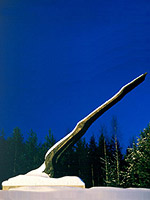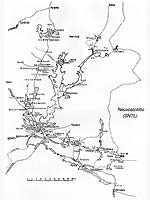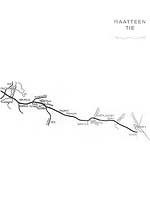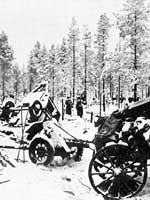| The Winter War Battles In Suomussalmi Events Along The Raate Road, 1939-1940 |
|
|
During the Winter War (11/30/39 – 3/13/40) the decisive battles around Suomussalmi were fought between November 30, 1939, and January 10, 1940. Of the few small skirmishes which took place subsequent to this major struggle, the attack mounted by the Russians against Raate on the anniversary of the founding of the Red Army was perhaps the most significant. It took place between the 21st and 23rd of February, 1940. The war zone for the major battles covered the entire eastern part of Suomussalmi, including, in particular, Juntusranta, Kiannanniemi, the church village of Suomussalmi, and Raate. The attached map indicates how the struggle developed; and this summary of events deals with the battles around the church village of Suomussalmi and along the Raate road. It should be mentioned that the author in no manner wishes to downplay the very important and bitter battles which were waged in other areas to the north of the church village of Suomussalmi at Kylänmäki, Palovaara and Piispajärvi. |
|
The Flame monument. Sculptor Alvar Aalto, 1960.
Karhulanvaara © Suomussalmi commune |  |
|
The International Situation With Regard To Finland At The End Of The 1930's National Socialist Germany armed itself extensively and carried on expansionist policies. In German-Soviet relations the non-aggression treaty of August 23, 1939, included dividing up territories into spheres of influence. Finland was considered to be in the Soviet sphere of influence. The Second World War began with Germany's attack on Poland on September 1, 1939. The Soviet: Union occupied the eastern part of Poland and concluded an agreement with Germany at the end of September defining Poland's new borders. The Soviet Union undertook to secure its own borders in the Baltic by offering mutual assistance treaties to the Baltic states while demanding military base privileges from those states. At the beginning of September Finland also increased its border patrols and strengthened its land, sea and air forces. October 5: The Soviet Union urged the Finnish government to send its representative to Moscow to discuss concrete political questions. The same day the Finnish National Guard was given the order to begin mobilization. October 6: the Finnish government ordered its National Guard mobilized and put its Navy and Air Force on a wartime footing. October 9: the Finnish Councilor of the State, Juho Kusti Paasikivi, traveled to Moscow for discussions which began on October 12. The exchange of territory proposed by the Soviet Union was considered impossible for the Finnish government to accept. October 7: the order was given for three field army divisions to carry out additional exercises starting on October 10. On October 12 the order came through for the exercises to be extended to the rest of the army. Civilians began to be evacuated from the southeastern border area. October 18 – 19: In a meeting in Stockholm of heads of state from Nordic countries Finland was given to understand that it would have to stand alone against the Soviet superpower. November 13: the discussions in Moscow ended in a deadlock. The Soviet press and radio began hotly attacking Finland, and Soviet troops started concentrating near the Finnish border. November 26: The Soviet Union claimed that Finland fired shots at Soviet troops at Mainila and demanded that the Finnish forces withdraw 20 – 25 kilometers from the border area. November 27: Finland forwarded a diplomatic note to Moscow claiming that the shots at Mainila were fired by the Soviets and proposing continuation of discussions. November 28: The Soviet Union cancelled its non-aggression pact with Finland. November 29: The Soviet Union broke off diplomatic relations with the Finnish government. November 30: The Soviet Union began to attack Finland by land, sea and air. The Situation In Kainuu And Suomussalmi In The Fall Of 1939 The Kainuu border guards were responsible for training draftees and reserves as well as the volunteer defense force for the Suomussalmi area. When the order for additional training came through, the Suomussalmi Training Center was set up accordingly. Lieutenant-Colonel Leo Kyander, commander of the Kainuu border guards and head of the Kainuu military district, was put in charge. The men under his command came from Suomussalmi, Puolanka, Hyrynsalmi and Ristijärvi. The staff of the Suomussalmi Training Center operated from the Kaleva Inn building in the Suomussalmi church village, and troops were housed in the church village, in the Karhulanvaara vicarage, in the Betania Children's Home at Haukiperä, at the border guard barracks at Ämmänsaari as well as at the Mattila house on the Raate road. The total strength at the Training Center was 1,679 men in addition to several Suomussalmi Lottas1. The goals of the training included company size battle preparation, marching exercises with full field packs, two-day battalion military exercises, target practice, and field fortification construction. According to the Soviet Union the building of field fortifications near the border in 1922 ran counter to the agreement to maintain a peaceful border strip where the sustained presence of large battle platoons was prohibited. The border strip was much wider than the one in effect today, and in order to make sure the Finnish-Soviet agreement was fully honored the Finns transferred their troops at the end of each day from the area where the fortifications work was carried out back to their permanent barracks. The Border Guard During The Additional Training Period The increasing of border patrols during the additional training period was entrusted to border detachments I and II. As head of border detachment I, Reserve Lieutenant E.Lehto was in charge of the southern strategic focal point, the width of which was 69 km. His first platoon was located at Kuivajärvi, while platoon II was at Hyry, platoon III at Likoharju, platoon IV at Raate, Puras and Salmijärvi. One half a platoon was situated at Mattila with machine guns. Border detachment I had a strength of 244 men supported by 118 members of the local defense volunteers. The section's command post was at Likoharju. Border detachment II, under the command of Reserve Second-Lieutenant M.Elo, was responsible for the northern belt, the width of which was 80 km. Detachment II's strength of 42 men amounted only to that of a reinforced platoon. The command post was at Juntusranta. The War Starts: November 30, 1939 When war broke out, Special Battalion 15 was formed at the Suomussalmi Training Center and had to bear the brunt of the Russian 163rd Division's attack. In the northern part of the county in Lehtovaara at Juntusranta the Russian 81st and 662nd Infantry Regiments launched attacks while the 759th was doing the same at Raate. The first objective of the Russian Division was the capture of the Suomussalmi church village to be followed by a drive across country to Oulu which would effectively cut Finland in half at its narrowest point. |
|
The places of main battles near Suomussalmi during the Winter war
© Suomussalmi commune |  |
|
Delaying The Russian Advance Towards Suomussalmi When the Soviet Union began its attack on the morning of November 30, Raate was defended by only a reinforced submachine gun squad which, after a short skirmish, withdrew to a delaying position at Myllypuro. This position was defended by one and a half platoons of riflemen in addition to half a platoon of machine gunners. As the Russians continued their attack and began to encircle the delaying position, the Finns withdrew at about 3:00 pm through the Purasjoki line to the Likoharju 'house to rest up. Finnish losses in these skirmishes were limited to a few wounded. The Purasjoki line was then manned by troops arriving from the church village. These included four rifle platoons reinforced by eight machine guns and a grenade-launching detachment. One platoon was held in reserve. In the Puras direction at Janismaa there were on rifle platoon, two sapper squads, one half of a machine gun platoon, the battalion's gas defense unit and four border guards. In the Kuhmo road direction there were two platoon and a sapper squad. The sappers blew up the Kattilakoski bridge at dusk. Between the first and third of December successful defensive actions were carried out in the vicinity of the road, but the threat from the Puras direction was increasing and it became necessary to transfer platoons there in response to it. On December 3 Soviet platoons attacked the defense line supported by artillery and grenade-launchers. In the early hours of the afternoon the aggressors succeeded in circling behind the defense position from the north, but the move was successfully countered. However, due to their precarious situation the Finns were constrained to abandon their positions between the third and fourth of December. Fortunately on December 3 additional platoon from Kajaani had reached Suomussalmi and included the field reinforcement brigade's 4th Battalion. The next line of defense was set up in the countryside near Mattila, about 10 km west of Purasjoki. In the narrow Kokkojärvi-Teerinen-Pyöreäinen strip of land a much larger troop concentration could be undertaken than had been possible at Purasjoki. The Finns now had enough platoons to be able to begin counter-attacking on December 5. The attack had to be broken off at sundown, however, and the troops returned to the Mattila line by December 6. The Loss Of The Suomussalmi Church Village On the following day the Finnish troops had to abandon Mattila and transfer to Haukipera, the southern bank of the Kianta lake waterway, due to the fact that the Soviet troops had taken the church village of Suomussalmi and were beginning to encircle the Finnish position. This ended the first stage of the battles in the Raate road direction. The Soviets were able to unite their troops in the church village, which had been set afire by the retreating Finns. All Finnish troops had withdrawn by December 8 to the defensive position on the Kianta lake waterway's southern bank. At the main focal point near the Haukipera ferry landing the defensive positions were immediately reinforced. December 8 went by relatively calmly but on December 9 dawn saw the Soviet troops, under cover of artillery and grenade-launchers, cross the channel and manage to penetrate the Finnish positions. They succeeded in moving as far as the first major crossroad before the Finns could launch a successful counterattack to throw them back. The Finnish troops were helped by the fact that the ice which was strong enough to carry the Russian soldiers was not yet thick enough to support the Russian tanks and heavy equipment. The Suomussalmi soldiers got a badly needed shot in the arm with the arrival of Colonel Hjalmar Siilasvuo and his troops on December 9. This gave the Finns altogether five battalions, three separate companies and two reconnaissance detachments. There was, however, a serious shortage of artillery and anti-tank weapons. The Finns Take The Initiative Colonel Siilasvuo had been given a very simple order: attack and defeat the Soviet Division occupying the Suomussalmi church village area. The Finnish attack on the church village began on December 11, 1939. Lieutenant-Colonel Mäkiniemi's 27th Infantry Regiment attacked from the east sweeping around toward the southern half of the church village. By mid-day they had reached the Kuhmo-Suomussalmi road (the Raate road) in Palovaara. The main platoon now turned toward the church village and fought until December 18 without managing to deal a decisive blow. Siilasvuo concentrated his own attack at Hulkonniemi. The struggle was carried on by small units from December 11 until December 28 when the Russian troops broke off and withdrew over the ice of lake Kianta to Juntusranta leaving the Suomussalmi church village again in the hands of the Finns. Shortly before the end of the battle Siilasvuo received reinforcements in the form of the 64th and 65th Infantry Regiments. Siilasvuo's troops were then formed into the 9th Division. During the church village battles Siilasvuo protected his rear at Kuomasjoki in the direction of Raate. The Kontula detachment of about 300 men stationed there successfully fulfilled their task of stopping the point troops of the elite Soviet 44th Division approaching along the Raate road. |
|
The Raate Road
© Suomussalmi commune |  |
|
The Raate Road Battles As soon as the battles to the north of the Suomussalmi church village has swung in the Finns' favor, Siilasvuo transferred all the forces that could be spared to the Raate road area where the Russians occupied the stretch between Kuomasjoki and Likoharju, with the main body of their troops in the area of Haukila. Siilasvuo's plan was once again simple and clear: the Russian supply line to the border were to be cut, following which the line of troops along the road was to be systematically cut into smaller segments, called "mottis" by the Finns2. The "mottis" were to be isolated from each other and then destroyed. In order to carry out this plan a road was cleared over the frozen lakes in the Alanteenjärvi-Vuokkijärvi area paralleling the Raate road. This newly cleared road was then used for assembling troops and providing them with food, shelter and supplies between attacks. Siilasvuo's troops began their attack at the beginning of 1940. The main thrust of the attack was at Haukila and came from the north and south. The Finns successfully cut the Raate road in the eastern part of Haukila while at the same moment the Russian troops in the southeastern area of Haukila at Sanginlampi and in Eskola in the direction of the Kuhmo road were totally wiped out. Those Soviet troops which remained immobile in the areas of Haukila, Karila, Tyynelä and Mattila found themselves being swiftly surrounded. The decisive battle for Raate began on January 5, 1940. The Finns attacked the Raate road in the vicinity of Raate close to the Finnish-Russian border in company strength. At Likoharju they attacked with about a battalion of men and finally overran the Russian position after several attempts. The following day the Finns succeeded in blowing up the bridge at Purasjoki while Siilasvuo's main troops attacked the isthmus between Teerinen ja Kokkojärvi. All these battles contributed to bringing a speedy conclusion to the struggle. The end came at Haukila when the Finns attacked and destroyed what remained of the Soviet forces. Three regiments of the 44th Division were squeezed into a very small area and cutting their escape route to the east closed the trap. They then became for all intents and purposes a "motti". The Finns' only weak point lay in the direction of Puras but that was quickly reinforced, and the Finns troops then used the time between January 5 and 7, 1940, to destroy all the "mottis" of Russia's elite 44th Division. By the evening of January 10 the Suomussalmi area had been cleared of any remaining Soviet presence and the battles were at an end. The Russia attempt at a break-through to the west had failed. Thereafter the area saw only a few minor skirmishes. The largest of these occurred when three Russian battalions carried out an attack on Raate during the period between February 21 and 23, 1940, on the occasion of the anniversary of the founding of the Red Army. The majority of Siilasvuo's troops were soon transferred to the front at Kuhmo and Ladoga in Karelia where bitter battles were to take place. When peace at last descended on March 13, 1940 at 1.00 am, the border in Suomussalmi remained intact. The losses on both sides had been substantial. |
|
The Soviet column destroyed on the Raate road
© SA |  |
|
The Situation For Civilians In The Period Shortly Preceding And During The Outbreak Of The War Despite the increase in military preparedness and the worsening of the political situation the civilian population was not evacuated as had been the case, for example, in the Karelian isthmus. Many houses in Suomussalmi near the border were not served by roads and were thus extremely difficult and slow to reach during that period of the year when the ground was soft and not yet frozen. Since the men of the region had been called to arms, the women, children and old people were left to fend for themselves in general uncertainty as winter approached. For the civilian population along the border, November 30, 1939, began as a completely normal winter day. The Soviet attack came as a total surprise. Since evacuating the civilian population from their homes in out-of-the-way locations was impossible, they were left at the mercy of the Soviet aggressor, with only the international laws covering the treatment of civilians during time of war to protect them. Those members of the population which lived further away from the border had more warning time and many of them fled on their own initiative along the edges of the roads – now full of military transports – leaving all their possessions behind them. In places where time and the military situation permitted, members of the border guard detachment came to the aid of civilians and helped them evacuate the area. In Suomussalmi 266 people were taken prisons: by the Russians and transferred to a labor camp at Kintismäki on the other side of the border. Thirteen of these prisoners died, but the rest were allowed to return home in June of 1940. The buildings in the parish of Suomussalmi were set afirp by the retreating Finnish troops with the worst destruction occurring, as might be expected, in the areas of heaviest fighting: along the Raate road; on the road leading from the Suomussalmi church village to Kuusamo as far as Piispajärvi, and at Juntusranta and its surrounding area. In addition, the villages of Ylivuokki, Alavuokki, Saarivaara, Kuivajärvi and Marjokylä were also burned. All in all about 270 buildings were burned in the county of Suomussalmi and the financial loss cannot be estimated. In Closing The Suomussalmi and Raate road battles showed that technical superiority does not necessarily guarantee victory in winter warfare. The decisive factor was the infantry soldier and his familiarity with forest warfare. The Soviet soldier did not give up, however, but fought to the bitter end: he had no other option.
Suomussalmen kunta |
|